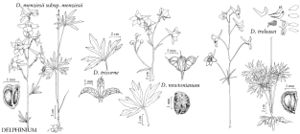Delphinium newtonianum
Rhodora 41: 196. 1939.
Stems 40-90 cm; base often reddish, puberulent. Leaves mostly cauline; basal leaves usually absent at anthesis; cauline leaves 2-8 at anthesis; petiole 0.5-10 cm. Leaf blade round to pentagonal, 4-7 × 5-15 cm, nearly glabrous; ultimate lobes 3-7, width 8-20 mm (basal), 5-15 mm (cauline), widest at middle or in proximal 1/2. Inflorescences 8-20(-40)-flowered, as wide as long or nearly so; pedicel 1-4(-6) cm, pubescent; bracteoles 6-15 mm from flowers, green, linear, 1.5-5 mm, puberulent. Flowers: sepals dark to light blue, rarely white, glabrous, lateral sepals spreading, 12-14 × 6-7 mm, spurs straight to decurved, within 30° of horizontal, 10-15 mm; lower petal blades slightly elevated, ± exposing stamens, 4-5 mm, clefts 2-3 mm; hairs mostly centered near base of cleft, yellow. Fruits 8-12 mm, 3-3.5 times longer than wide, nearly glabrous. Seeds unwinged; surface of each seed coat cell with swollen, blunt, hairlike structures, barely visible at 20×, otherwise smooth.
Phenology: Flowering early summer.
Habitat: Slopes in deciduous forest
Elevation: 500-700 m
Discussion
No cases of hybridization are known. Delphinium newtonianum often occurs in mixed populations with D. tricorne. It normally does not begin flowering until 4-6 weeks after D. tricorne has finished.
Selected References
None.

